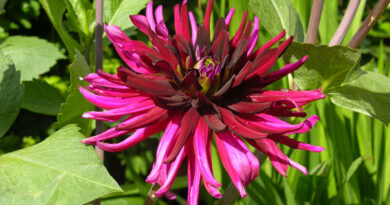Downy Mildew Killing Impatiens
Common impatiens, Impatiens walleriana, have always seemed the most indestructible of plants. You stick them in the ground, give them plenty of water in the sun, not so much in the shade and they bloom like there’s no tomorrow. Hardly anything ever goes wrong. Now a new villain has arrived and it is devastating the busy Lizzie crop all over North America. Downy mildew is caused by a pathogen called Plasmopara obducens, a fungus like organism that is actually a member of the water molds family, Oomycota.
Although the disease was discovered in some wild impatiens (jewelweed) as far back as 1897 in Vermont, in recent times it has only been since 2002 that the pathogen first appeared in Britain. In 2011, the outbreak spread to the United States. It is now devastating impatiens in B.C. It is rampant in Ontario.
Experience with a related Plasmopara which causes downy mildew on sunflowers has shown it can survive in zone 3 soils for as long as 10 years. The spores can travel for short distances on the air and can also be transmitted by splashing. There is no cure once a plant has been infected. It must be destroyed and disposed of by bagging. If you find an infected plant remove it and all its neighbours at once.
Here is what to look for
To avoid infection, check the plants you are buying at the nursery. If you see any of the following symptoms, alert the retailer and buy your plants somewhere else. The disease is causing great concern among greenhouses, many of whom are planning to stop selling common impatiens for the time being.
Infected plants may have leaves that show as light yellow or a combination of stipple yellow and green.
Leaf edges curl downward and leaves look wilted.
The undersides of leaves may show the first telltale signs of the fuzzy white growth.
The blossoms drop and then the leaves, leaving the stems bare.
Stems collapse and fall over.
Other plants that may be carriers
Impatiens balsamina and several of the wild impatiens are also susceptible, although it appears that New Guinnea impatiens are resistant. The pretty little double impatiens are also at risk, as is any impatiens that is a hybrid of I. walleriana.







Pingback: My Fall Garden - barnett-knits.com